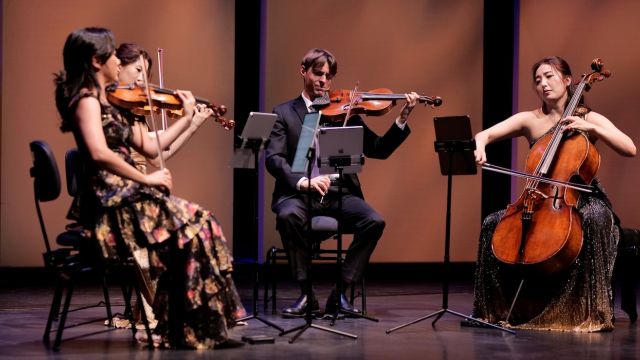Esmé Quartet
In the glorious acoustic surrounds of Adelaide’s Town Hall, the lauded Esmé Quartet astounded their audience on their first tour of Australia courtesy of Musica Viva. The group’s name, meaning “beloved”, is taken from medieval French and I feel sure that in future they will be welcomed back here to showcase their prodigious talents.
The original Esmé members met at the Hochschule für Musik in Cologne where the quartet was founded in 2016. All three current female members were born in Korea and since 2023 are joined by Belgian-American violist Dimitri Murrath. In 2018 they won the International String Quartet Competition at London's Wigmore Hall, one of the most prestigious quartet competitions in the world. Since then the group have released recordings and toured internationally to great acclaim. Wonhee Bae plays Violin I and Yuna Ha, Violin II. Viola is in the capable hands of Dimitri Murrath with Yeeun Heo on Cello.

The programme for this tour is an interesting mix that initially poses no thematic connection. However, as Murrath commented in one introduction, each piece is linked by the shared elements of youth (each composer was under 35 when the piece was written), passion, a combination of rhythmic passages contrasted with delicate lyricism, and a degree of romanticism.
Written in 1905 but not publicly performed until 1962, Langsamer Satz (“Slow Movement”) was apparently inspired by a hiking holiday in the mountains outside Vienna. Intending to write an entire quartet, Anton Weburn put it aside after completing only this one movement. Later to explore atonal styles like his mentor Schoenberg, this piece is richly layered with lyrical passages on cello overlaid by gentle pizzicato followed by swelling crescendos. The Esmé artists rendered this work with great dynamic range and simply magnificent tone.

The second offering was Felix Mendelssohn’s String Quartet No 2 in A Minor Op. 13 (1827), written when the composer was only 18. The four movements are Adagio — Allegro vivace, Adagio non lento, Intermezzo: Allegretto con moto —Allegro di molto, and Presto — Adagio non lento. The appealing structure of this piece contains a unifying motif taken from a love song the composer wrote in the months prior to beginning the quartet: The Lied — Frage, Op. 9/1 - it’s opening melodic line “Ist es wahr?” (“is it true”) ringing with the emotional poignancy of the teenage composer.
After interval, a contemporary Australian work truly stirred my interest. Jack Frerer’s Spiral Sequences won the 2019 Suzanne and Lee Ettelson Composer’s Award (USA). This composition in Frerer’s own words is “built around sequential chord progressions, which ascend or descend by consistent intervals”. There is a tense, dramatic and emotional force to the first section and the musicians responded with highly physical upper body motion to the long, legato bowing contrasting with shorter, flicked flourishes. In the second section, the composer describes an “unwinding” of the established patterns and the mood is more sombre, slower, and leans towards the lyrical.

The last piece was Claude Debussy's String Quartet in G Minor Op. 10 written in 1893 when he was 31 years old, his only work in this genre. The four movements follow the typical composition ‘rules’ but overall the music is in turn sensual, dramatic, dynamic in its volume and tempo shifts, and marked by a plethora of bowing techniques delivering texture and lush, surprising layers. All these challenges were handled by the musicians with astonishing maturity of interpretation alongside their very skilled playing.
The artists of the Esmé Quartet display a strong connection, a palpable camaraderie which only augments their superior technical prowess. It is clear they all have exceptional and precise command of their instruments and alongside this, their artistry is sublime. A breathtaking concert presentation that left the audience in awe of these musicians’ virtuosity and dazzling interpretive abilities.
Lisa Lanzi
Photographer: Tony McDonough
Subscribe to our E-Newsletter, buy our latest print edition or find a Performing Arts book at Book Nook.

